THERE IS A (PAID) HOLIDAY IN COSTA RICA IN JULY: Guanacaste Day, July 25
Guanacaste Day celebrates the entrance in 1824 of Guanacaste province, which prior to that time existed as a province autonomous from both Nicaragua and Costa Rica. It also was a historical site of critical importance during past attempts when the region was in danger of being overtaken by a famous "filibuster". It is now a place of many beach and mountain resorts as well as an important farming zone for Costa Rica. To read more go HERE.
Broken News
(All the News That's Fit to Reprint)
Love at First Flight
Some people, including yours truly, find the quarantine imposing and boring. Others are much more creative on how the time can be used.
 |
| Khani and Matt Enjoying Costa Rica |
Take Matt Robertson (31) and Khani Le (29), a couple of New Yorkers who had begun dating in the States and then decided to take advantage of some good buys in air travel down to Costa Rica for their third date. They got in under the wire so to speak, arriving in very early March.
They managed to get in some of the musts here such as zip-lining, but it wasn't long thereafter when the hammer came down and they found themselves forcibly quarantined in Ticoland with no way out, except perhaps swimming the Gulf of Mexico: all the flights to the U.S. were canceled in mid-March including their booking on Delta which was pushed back to July 2.
If you want to get to know someone, get quarantined with them. (Sounds like a new marketing possibility for travel agents - The Q-Tour) The couple bravely occupied their time finding reasonable accommodations and even learning new techniques like how to make good ceviche (mmmm). But they also got to know each other quite well, both of them making positive comments about what they learned of their partner's character.
By May 31 Matt and Khani had reached their 76th day in Costa Quarentino. They arranged to get a seat on one of the limited "repatriation" flights that had been put into effect by United Airlines that only went to Houston on certain days of the week. They finally flew out the first week of June. From Houston they would need to find a connecting flight to either Seattle (Khani's home town) or to Maine where Matt hails from.
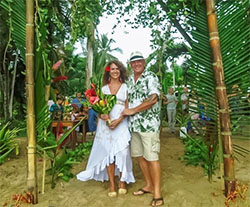 |
| Sandra and Kevin Sullivan |
Matt and Khani were not alone. Hung up on the Caribbean side of the country by the travel ban, Sandra Noy, originally from Barcelona, Spain and Kevin Sullivan from the U.K. had a solution to the inconvenience. They got married. Life partners before they came here they decided to make it permanent and official and used their location as a backdrop, the beautiful Caribbean coast of Costa Rica for their ceremony.
Said Sandra: “I’m going to explain, I just got married in front of the sea, surrounded by flowers, with the sand under my feet, the sunset sun was perfect when we said ‘yes, I accept!’ … we chose the best place in the world to get married, Paradise".
Congratulations amigos (and that's a beautiful dress for a beautiful lady).
New Puntarenas Hospital
Readers may remember that the Puntarenas Hospital (also known as Hospital Monseñor Sanabria), which services all of the Province of Puntarenas including Quepos, was severely damaged by the second biggest earthquake in Costa Rican history on September 5, 2012. GG was in the middle of it, something I can never forget. After more than a year of review and attempts to repair the building it was concluded that an entirely new hospital needed to be constructed. The top eight floors of the old ten story building were razed leaving a two-floor building now used for administrative purposes and specialty testing.
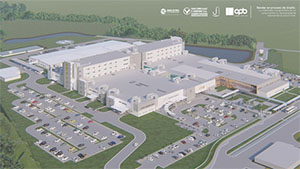 |
| Artist's Rendition - New Puntarenas Hospital |
Later it was announced by the C.C.S.S. that a new hospital would be created near Barranca, about 15 kilometers east of the old hospital. C.C.S.S. (Caja Costarricense de Seguro Social - affectionately known as the Caja), and which is the Social Security Administration, is also responsible for the health system. Years of scoping out the project and construction planning finally led to the Caja folks recently announcing that the project is underway and releasing some of the architectural drawings and hospital specs. Completion of construction is planned for late 2022.
At a cost of ₡132 billion colones or (about $230 million) the new facility will have 350 beds and service the 410,000 residents of Puntarenas Province (plus a few tourists I'm sure). The services will include an emergency center with 43 beds, a surgery block with 12 operating rooms, four natal care delivery rooms, clinical and administrative support services and 64 external consultation offices. Among the new expanded services offered are: hemodynamics, optometry, cardiology, critical medicine and intensive care, gynecology, oncology and chemotherapy.
Sounds like a full-service hospital to me. Well done CCSS; let's get her built amigos!
China Pledges More COVID Help to Costa Rica
Relations between Costa Rica and China have grown closer and stronger over the last ten years. It started when Costa Rica changed its Chinese affiliation (diplomatic recognition) from Taipei to Beijing, or from Taiwan to the PRC or People's Republic of China in 2007. Costa Rica had maintained relations with Taipai for 60 years until then president Oscar Arias switched recognition of China to Beijing. In response (some say in exchange) Beijing donated the national stadium in San Jose (often referred to by many as the Estadio Chino).
So the relations between Costa Rica and China were pretty good when the Coronavirus hit. Shortly after the virus produced the first case of COVID-19 in Latin America in Costa Rica, and at the suggestion of the Chinese embassy in San José, a teleconference was held between Costa Rican health officials and Chinese health officials who had experience in treating the infected in Wuhan. What they learned from the Chinese was incorporated into the Costa Rican protocol.
Despite a recent up-tick in Coronavirus cases here the numbers of successful treatment still show an advantage over most countries. In a recent telephone call between Chinese President Xi Jinping and Costa Rican President Carlos Alvarado the Chinese leader said China will continue to support Costa Rica in fighting the virus.
U.A.E. Sends a Plane Load
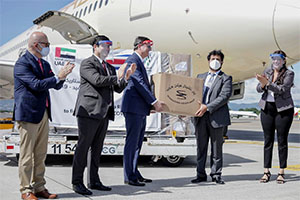 Hard on the heels of the Chinese pledge to help out in the Coronavirus, the United Arab Emirates recently sent a plane with nine tons of COVID fighting supplies as well as 10,000 testing kits. The plane also included a number of Costa Rican officials returning to their homeland. With an added personal touch, the UAE ambassador to Costa Rica was on the plane and personally delivered the supplies to Juan Santamaria Airport on Friday, May 12.
Hard on the heels of the Chinese pledge to help out in the Coronavirus, the United Arab Emirates recently sent a plane with nine tons of COVID fighting supplies as well as 10,000 testing kits. The plane also included a number of Costa Rican officials returning to their homeland. With an added personal touch, the UAE ambassador to Costa Rica was on the plane and personally delivered the supplies to Juan Santamaria Airport on Friday, May 12.
Said the UAE Ambassador: “The UAE is always keen to stand by brotherly and friendly countries and help medical teams that are among the most vulnerable to the pandemic.”
That's why we're known as the happiest people on the globe. Thanks UAE amigos.
¡Pura Vida!
TOP
Economic Drumbeat
(Costa Rica Business and Economic Happenings)
GG was very happy this month to see a more robust economy and a sizable increase in expansion plans for companies in Costa Rica - the last couple of virus months were eerily quiet on good news.
Olive Garden to Open Here
 The Italian restaurant chain Olive Garden, with some 850 restaurants in the U.S. and about the world, has been planning for some time to enter Costa Rica. They had originally targeted July for opening of two restaurants in the Central Valley in Santa Ana and Escazu but the situation with COVID has changed their opening plan to September.
The Italian restaurant chain Olive Garden, with some 850 restaurants in the U.S. and about the world, has been planning for some time to enter Costa Rica. They had originally targeted July for opening of two restaurants in the Central Valley in Santa Ana and Escazu but the situation with COVID has changed their opening plan to September.
Over $2.5 million is expected to be invested in the new restaurants along with hiring of at least 50 personnel.
VAT on Cross-Border Digital Services
 The Costa Rica legislature some time ago passed a revision to the tax code that in essence replaces the current tax system with a VAT (Value Added Tax) system. At the same time, spurred on by mounting deficits, deteriorating international credit and poor fiscal performance ratings, the new tax code broadens the number of products and services which are to come under the VAT system.
The Costa Rica legislature some time ago passed a revision to the tax code that in essence replaces the current tax system with a VAT (Value Added Tax) system. At the same time, spurred on by mounting deficits, deteriorating international credit and poor fiscal performance ratings, the new tax code broadens the number of products and services which are to come under the VAT system.
So it was not surprising that the government recently announced that, effective August 1, digital trans-border services will now be taxed at the 13% VAT rate. Their definition of these is: Digital trans-border services encompass all those that are offered by a provider not located in the country through the internet or a digital platform to consumers in Costa Rican territory.
Think Netflix, Airbnb, Uber, Amazon and many others. I'm not sure how Uber qualifies for the VAT if you just use it locally but I am sure the regular taxi drivers are keeping the pressure on the government to make sure the Uber boys (and we) pay as much as they do.
Malls Reopen for Father's Day
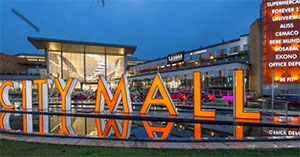 The major shopping malls in Costa Rica, primarily in the Central Valley (e.g., Multi-Plaza in Escazu and City Mall in Alejuela) were reopened for business on the weekend of June 20, Father's Day, after being closed for over three months because of the pandemic.
The major shopping malls in Costa Rica, primarily in the Central Valley (e.g., Multi-Plaza in Escazu and City Mall in Alejuela) were reopened for business on the weekend of June 20, Father's Day, after being closed for over three months because of the pandemic.
The new normal for operation is a restriction by the stores to 50% of capacity (however you manage that). But it is a return to a form of normalcy and appreciated by the general public and the merchants, many of which offered substantial discounts on a variety of merchandise.
PriceSmart Adds 8th Store in Costa Rica
At a cost of over $16 million and an expected employment of 125, PriceSmart, a leader in warehouse club stores, opened its eighth store in Costa Rica on June 17. The San Diego, CA based PriceSmart, which has operated here for 20 years, now has more stores in Costa Rica than any other Latin American country (Aruba (1), Barbados - 1, Colombia - 7, Costa Rica - 8, The Dominican Republic - 5, El Salvador - 2, Guatemala - 4, Honduras - 3, Jamaica - 1, Nicaragua - 2, Panama - 6 and Trinidad and Tobago - 4).
 What's unusual about this 6,600 square meter (70,000 square foot) store is that it's the first time PriceSmart has ventured outside the San José GAM (Grande Area Metropolitano or Greater Metropolitan Area). The store is in Liberia, a town in North Western Costa Rica which is more and more seen as an important commercial hub.
What's unusual about this 6,600 square meter (70,000 square foot) store is that it's the first time PriceSmart has ventured outside the San José GAM (Grande Area Metropolitano or Greater Metropolitan Area). The store is in Liberia, a town in North Western Costa Rica which is more and more seen as an important commercial hub.
Reports are the store saw long lines of cars approaching the site driven by eager shoppers. Watch the 50% rule amigos (but enjoy the new convenience).
Sykes to Add People
Sykes Enterprises Inc. has also operated in Costa Rica for 20 years. Not being familiar with this company I looked up what they define themselves as and saw this:
 SYKES ENTERPRISES, INCORPORATED is a leading provider of multi-channel demand generation and global customer engagement services. The Company provides differentiated full life-cycle customer engagement solutions and services primarily to Global 2000 companies and their end customers.
SYKES ENTERPRISES, INCORPORATED is a leading provider of multi-channel demand generation and global customer engagement services. The Company provides differentiated full life-cycle customer engagement solutions and services primarily to Global 2000 companies and their end customers.
Whew! When I read stuff like this I just want want to say: "Yeah, but what the hell do you do?". The next thing I found was that they are an International BPO and Customer Experience Company. BPO? Turns out that means Business Process Outsourcing (such as accounting, payment processing, IT services, human resources, regulatory compliance, and quality assurance). OK! So they provide people and organizational talent to companies that either can't or prefer not to do certain things themselves. They're a bunch of successful ($2 billion annual sales) outsourcing dudes.
Their announcement was that they would add 450 "teleworkable" jobs to their current base here of over 5,000 (really?). I guess teleworkable means you can work from home (or another remote location). Come on GG, get with the modern terminology.
¡Pura Vida!
TOP
Latin America Updates
(Major Events In Neighboring Countries)
El Salvador
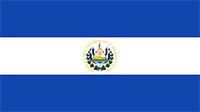
When the rainy season comes as mentioned below, Central America can be hit from both the Pacific and Caribbean sides. Yet it was still a shock to many Salvadorans when a ferocious tropical storm recently hit the country coming at it from the Pacific Ocean.
Damage from wind, flash flooding and mudslides was severe and widespread and 14 people were killed by collapsing buildings or swept away by swollen rivers. The government of President Bukele quickly declared a national emergency. The U.S. National Hurricane Center forecasted a total of 10-15 inches of rain over a 2-3 day event including parts of Guatemala, Honduras and some of the southern states of Mexico.
The storm, dubbed Tropical Storm Amanda, registered maximum sustained winds of 65 kilometers per hour (40 mph) and higher, hurricane-level gusts. The tormenta weakened quickly as it proceeded inland but continued its heavy rainfall.
Nicaragua

Border Leakages Continue
Last month the Chronicles noted a number of border leakage problems adding to the COVID problem and caused by unwary truckers coming through Costa Rica. They came from north and south and a number of them had contracted the disease while passing through Nicaragua. The Costa Rican government has since shut down hard on this source by instituting extra testing and the use of trucking caravans with restricted personal access that are supervised by the police. Panama agreed to the procedures but Nicaragua balked.
The Nicaraguan border situation is getting more difficult as people slip across the border in a variety of ways and for several reasons, including wanting work. During a recent period of spiking in the Costa Rica cases (439 cases from June 1 to June 15) 90 new cases were produced in one day, a record (at that time). Half of these were from two meat processing plants not far from the border known to be heavily staffed by migrant Nicaraguan workers.
Another reason for slipping over the border, which is now closed to all non-Citizens and non-residents might be wanting to visit family. Remember that as much as 15% of the Costa Rica population (about 750,000) originated in Nicaragua. The only official border crossing is at Peñas Blancas, on the far western end of the border and that leaves most of the 309 km (185 mile) border open to a number of "blind spots" where it is relatively easy to cross. About a third of that distance is the San Juan river subject to a quick boat ride to get across.
Another reason for coming across is to escape a country which basically and officially can be summarized as ignoring the COVID disease and and has no official protocol for treating it but instead simply records COVID cases as "atypical pneumonia". As a result, Costa Rica has significantly increased its border patrol including more police and air surveillance. We'll see how effective it turns out to be.
120 Nicaraguans Refused Entry by Nicaraguan Border Officials
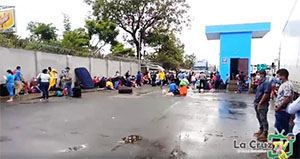 |
| Nicaraguans Held Up at Penas Blancas |
In the midst of all the border problems a bus left Panama containing 120 Nicaraguan nationals who had been held up in Panama by the COVID-19 problem, The bus was subject to caravan restrictions meaning it could only proceed directly from the Panamanian border with Costa Rica to the Costa Rican border with Nicaragua (my guess is that's at least 8 hours).
When they arrived at that border, Peñas Blancas, they were first refused entry by Nicaraguan border officials but after 18 hours of waiting and negotiations they were finally allowed to enter their home country.
¡Solo Bueno!
TOP
Rumble and Weather Talk
(Shaky Happenings and Weather Observations On or About the Pacific Rim)
Weather
Rainfall has been heavy at times. We are still at the beginning of the rainy season but we are experiencing intermittent heavy rains caused by various "tropical waves" coming off the Caribbean Sea and/or the Pacific. Nothing terribly unusual and everything is green (yeh).
Sahara Dust Cloud Reaches Costa Rica
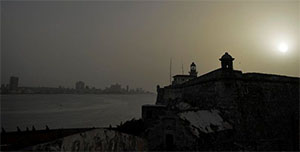 |
| Saharan Dust Cloud Over Havana, Cuba |
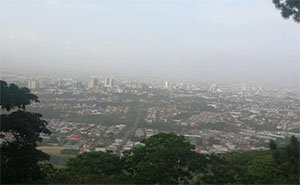 |
| San José Under the Dust Cloud |
In early June a huge dust cloud formed over the Sahara dessert in East Africa and proceeded to head east following a path similar to the ones used by hurricanes which also form from hot winds escaping East Africa. At one point the length of the dust cloud reached more than 4,000 miles across.
The cloud reached the Americas and the Caribbean, including Costa Rica, in late June and in some cases literally blotted out the sun, like the top photo right which shows Havana, Cuba seriously darkened by the cloud.
The effect in San José, Costa Rica was less dramatic because we are on the fringes of the cloud (that condition is also similar to what occurs here with hurricanes). But the cloud was quite obvious nonetheless. Meteorologists noted that because of specific meteorological flow conditions, the height of the central valley put it in a position more likely to feel the dust cloud than other, lower areas. Like Quepos? But there was a certain grittiness in the air this morning when I went into town.
Health officials also warned that the dust can aggravate asthmatic and bronchial conditions. Maybe we have yet another reason to put on the Coronavirus mask.
Rain and Tremor Connection
After living here a few years and experiencing heavy rains and earthquakes I began to wonder: could there be a connection? Having studied a bit of physics and engineering principles along the way it seemed to me logical that the earth's surface, deeply saturated with water, could exert a significant pressure on tectonic plates and their faults and might cause them to move, creating a tremor. Now scientists are beginning to study the relationship between heavy rainfalls and earthquakes and are coming to understand that there is some kind of relationship (they beat GG to the discovery).
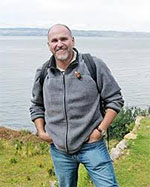 |
| Shimon Wdowinski |
One professor watching this phenomenon is Dr. Shimon Wdowinski of the University of Miami. He holds a slew of credentials: BSc in Earth Sciences, MSc in Geology, MS in Engineering Sciences and a PhD in Geophysics, and has been following the data for years. His conclusion: it's likely that the tremor occurs not when the water exerts a downward pressure but later as the water dissipates and is aided by landslides. The relief of the weight of the water "unlocks" the joint between the tectonic plates allowing them to slide and causing the tremor.
The time between the heavy rains and the resulting tremor can be a few months to a few years. Some recent examples he offers (several of them are from Taiwan where major rainstorms and tremors are common and where the good professor studied 50 years of records):
-
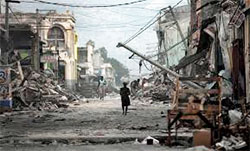 |
| 2010 Quake in Haiti |
1999: 7.6 quake hits Taiwan three years after Typhoon Herb soaked the island with almost 80 inches of rain.
- 2009: 6.4 quake hits Taiwan seven months after Typhoon Morakot drops 2.9 meters (114 inches) of rain on the island.
- 2010: 7.0 quake hits Haiti 18 months after it was deluged by hurricanes and tropical storms.
- 2012: 7.6 quake (second largest in the country's history) hits Costa Rica less than two years after record rainfalls of 2010 cause major landslides and road washouts, including Manuel Antonio.
Oops, sorry, Dr. Wdowinski didn't add that last one, GG did. But the good doctor has me thinking about the relationship again, that's for sure. The academic community is now applying a new term to this phenomenon: "disaster triggering disaster."
¡Pura Vida!
Check Out Recent Earthquakes Around the World Posted by the U.S. Geodetic Survey: Recent Quakes |
TOP
Search the Golden Gringo Chronicles Archives for Topics That Interest You
You can use our Archives to search for anything that has been written in more than 260 feature articles of the Golden Gringo Chronicles plus find Broken News items and ROMEO restaurant reviews. Enter your topic or item to search in the Google Search Routine below and follow the links offered from the search results. Suggestion: Enter only a simple, precise and unique as possible keyword or
two in order to narrow the number of references retrieved:
Golden Gringo Chronicles - Enter Search Here
Readers: Our publication is open to suggestions regarding future articles
and will accept pieces written by others but we reserve the right to decline
anything that the
editorial staff (that's GG) thinks is inappropriate for this format. Send proposals, comments, suggestions, ideas, meaningless statements and jocular observations concerning the Chronicles to GG here: gg@goldengringo.com.
The Coffee Story
(Part 1 - The History of Coffee)
GG recently received a forwarded YouTube link from a good expat friend in San José. It was all about coffee, it's history, its industry and its benefits to mankind. Having become a devotee of this beverage over my lifetime I found the series spellbinding and decided to summarize it here over three parts. This month is Part 1, the history of coffee.
GG is well aware that some people cannot take coffee for health reasons such as high blood pressure. The information here is presented for only those that can or should drink coffee; check with your doctor if you're not sure.
There is no other beverage, including alcoholic ones, that has captured the interest and imagination of mankind more than coffee. Let's start with the fact that coffee is currently the second most widely traded commodity in the world as measured by dollar value; the only one that beats it is oil (maybe it's number one at the moment considering the recent crash in the price of oil).
Some version of coffee is drunk in virtually every country of the world and many countries become famous for growing high quality beans with special flavors, like Costa Rica. Estimates are that 2.25 billion cups of coffee are drunk every day around the world, half for breakfast.
It all started in Ethiopia about a thousand years ago. Exactly how the first taste of the coffee beverage was experienced is not certain because different tales of how it began persist.
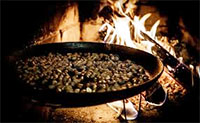 The YouTube history report on which much of this article is based talks about a sheppard who noticed that his flock was unusually active after eating the berries of a certain bush. That bush turned out to be an arabica plant. The sheppard tried eating the ripe, red berries straight from the bush like his flock did; he found them bitter and they did not increase his energy. Later he discovered that some berries had accidentally fallen into a cooking pan where they were unintentionally roasted and when crushed and dissolved in water, the odoriferous and tasty liquid that resulted changed everything. Le voila! For many years thereafter, and even today, it is not unusual to see coffee beans skillet-roasted over an open fire in parts of the world, particularly Arabia where it often is done ceremoniously.
The YouTube history report on which much of this article is based talks about a sheppard who noticed that his flock was unusually active after eating the berries of a certain bush. That bush turned out to be an arabica plant. The sheppard tried eating the ripe, red berries straight from the bush like his flock did; he found them bitter and they did not increase his energy. Later he discovered that some berries had accidentally fallen into a cooking pan where they were unintentionally roasted and when crushed and dissolved in water, the odoriferous and tasty liquid that resulted changed everything. Le voila! For many years thereafter, and even today, it is not unusual to see coffee beans skillet-roasted over an open fire in parts of the world, particularly Arabia where it often is done ceremoniously.
Another version of how coffee was first found and appreciated involved the shaman to a sheik who also noticed some animals that chewed on the arabica beans were much more active than others. The shaman's Sheik at the time was suffering from an undefined (at least to us) illness. The shaman somehow also discovered that roasting product was necessary before the steeped product became helpful to his master. In a few days, just drinking strong coffee the sheik recovered quickly (now that's a health food). The shaman was notably rewarded and later became a saint in the Muslim religion.
 A few hundred years later Turkish caravans passing through Ethiopia discovered coffee and how to prepare it. They brought plants back to Istanbul where many of the rich and powerful fell in love with the brew. Turkish authorities were very careful to keep the secret of the beans to themselves and from the world for a long time but eventually someone cleverly smuggled beans out of Turkey. He secreted some of the beans under his clothes tied to his stomach. Word of the magic elixir spread to other lands.
A few hundred years later Turkish caravans passing through Ethiopia discovered coffee and how to prepare it. They brought plants back to Istanbul where many of the rich and powerful fell in love with the brew. Turkish authorities were very careful to keep the secret of the beans to themselves and from the world for a long time but eventually someone cleverly smuggled beans out of Turkey. He secreted some of the beans under his clothes tied to his stomach. Word of the magic elixir spread to other lands.
The 1500's and 1600's were a great period of expansion of the use of coffee, a time when the bean finally arrived in Europe. In 1529, at the siege of Vienna, the Arabs were rebuffed but left behind bags of roasted beans that were originally intended to be used within their war party. A few of the Viennese knew what they were and also had contacts in Ethiopia with whom they arranged to supply the beans and, more importantly, some of the plants. The era of coffee in Europe had begun and for the next century the coffee craze spread like a pandemic across most of the major countries in Europe from Italy to Great Britain and Spain to Scandinavia.
By the end of the 16th century most of Europe had discovered coffee. The Dutch, ruling much of Indonesia at the time and taking their supply chain seriously, forced the people of their Java colony to produce coffee, thereby becoming a major world supplier of the bean. Forced coffee production there would later be the cause of a major slave rebellion. That rebellion would see many of the coffee and sugar plantations burned to the ground. Later, Napoleon's forces tried to retake the rebel island but failed when the slaves fought back ferociously and fended off the French.
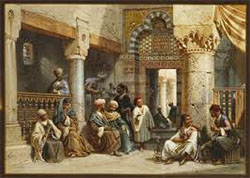 |
| Early Arab Coffee House |
During this period, places of gathering to drink the beverage which came to be known as coffee houses, popped up everywhere. Here was a place intellectuals could argue about philosophy, artists could entertain and politicos could foment rebellion. At the same time the coffee houses broke class barriers, you didn't have to be a rich person to enjoy a cup of coffee.
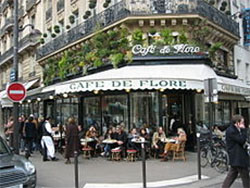 The French adopted the coffee house tradition with relish but eventually took to calling them cafés. One of the more famous of their cafés, which is still in operation today, is the Café de Flore - shown in the photo to the left.
The French adopted the coffee house tradition with relish but eventually took to calling them cafés. One of the more famous of their cafés, which is still in operation today, is the Café de Flore - shown in the photo to the left.
The Italians continue to claim they taught the French how to make coffee to which Les Francaise say "Mais, non, non non". The Italians (two of them in Turin, Italy) also claim they invented espresso to satisfy a customer who was in a rush. As far as I know the French don't argue with that. One of the Italian coffee houses was reportedly a hang-out for Cassanova himself. Even the Pope tried the brew and after tasting it he blessed the beans and the idea with enthusiasm.
Coffee and coffee houses changed class behavior. There was no alcohol (at least initially), something the Arab world leaders liked because it was in agreement Muslim teaching. Later however, the mullahs would come after the coffee houses because of the mild drug effect of caffeine. Women were not included in the coffee houses as patrons but as time developed, prostitutes, male and female, would do business in either the floor above the main room of the coffee house or in the basement below.
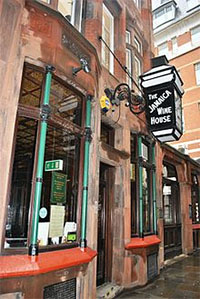 The first coffee reached England in the mid-1600's followed soon by the opening of the first coffee house in London by a Armenian Jewish immigrant named Pasqua Rosée who had connections with bean suppliers in the Mediterranean. The space where Rosée's coffee house first existed, in St. Michael's Alley, Cornhill is currently occupied by the Jamaica Wine House (don't know what kind of coffee they offer in addition to wine). By 1700 there were over 200 coffee houses in England that were dubbed with the nickname "Penny Universities" because of all the information that was passed in them.
The first coffee reached England in the mid-1600's followed soon by the opening of the first coffee house in London by a Armenian Jewish immigrant named Pasqua Rosée who had connections with bean suppliers in the Mediterranean. The space where Rosée's coffee house first existed, in St. Michael's Alley, Cornhill is currently occupied by the Jamaica Wine House (don't know what kind of coffee they offer in addition to wine). By 1700 there were over 200 coffee houses in England that were dubbed with the nickname "Penny Universities" because of all the information that was passed in them.
The French also claim to have brought the first coffee plant to the Americas. Reportedly a young man transported a plant in a soil box and watched over the plant carefully so that no-one would abuse it. While on the ship he also shared his daily ration of water with the plant to keep it healthy. The plant was installed in the French territory of Martinique but later another plant was transferred to Haiti, also a French colony. That's how the Americas first got into the coffee business.
By 1790 production of coffee in Haiti was equal to one half the world supply!
So in a nutshell that's how coffee historically got started and expanded in popularity. To see more info on coffee, previously written in the Chronicles, follow the links below:
Edition 43 March 2012: Coffee Versus Type II
Edition 82 June 2015: Coffee as Health Food
Edition 92 April 2016: Coffee Talk
Edition 97 September 2016: On Being a Catador
Edition 109: September 2017: Coffee Studies Again Positive
Edition 122: October 2018: Health Foods: Red Wine, Coffee, Chocolate
Next month: Part 2 - Coffee as Business
Two months: Part 3 - The Perfect Cup
¡Pura Café!
TOP
¿Que es Eso? Department
(What is That?)
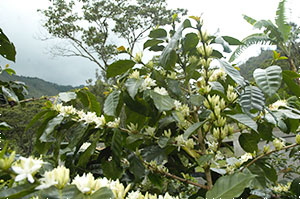
Just Another Spring Flower eh?
Why is This One Different?
Answer in
What's-in-a-Word
section below.
¡Pura Vida!
TOP
Golden Gringo University
(Getting Citizenship in Costa Rica)
The idea behind Golden Gringo University is to present educational topics of wide interest to expats who have recently moved to Costa Rica, or to future expats who might be thinking of moving here, or to those who simply visit here frequently. The goal and objective of Golden Gringo University is to provide accurate information that readers will find helpful in their efforts to be a good expat, a resident in, or a visitor to Costa Rica.

The information presented here is believed to be the best available at the time it was published but rules and regulations of the Government of Costa Rica change frequently so we believe you should confirm with a government representative and/or a professional intermediary what is suggested here BEFORE you begin the process yourself. |
Now to the topic for this month:
Getting Citizenship in Costa Rica
GG made application for naturalized citizenship on September 20, 2019. I thought it would be useful to go over the details of the process involved for those who also might be thinking of pursuing this.
 The first thing to realize in this process is that, unlike getting an official residency cédula (a cédula is an official identification card similar to a credit card), you are not dealing with the immigration department (called Inmigración here). Instead you will be working with the TSE (Tríbunal Supremo de Elecciones - Supreme Court of Elections). This is an organization that was instituted at the same time that the constitution of the Second Republic was adopted in 1949. It was formed with the intention of securing valid and democratic elections, a deep concern in the country at that time as they struggled to emerge from a bitter civil war.
The first thing to realize in this process is that, unlike getting an official residency cédula (a cédula is an official identification card similar to a credit card), you are not dealing with the immigration department (called Inmigración here). Instead you will be working with the TSE (Tríbunal Supremo de Elecciones - Supreme Court of Elections). This is an organization that was instituted at the same time that the constitution of the Second Republic was adopted in 1949. It was formed with the intention of securing valid and democratic elections, a deep concern in the country at that time as they struggled to emerge from a bitter civil war.
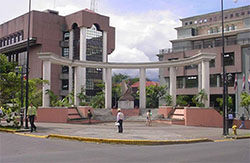 |
| TSE Headquarters - San José (Fear Not, There is a Smaller Branch in Quepos) |
TSE has been strengthened over the years and effectively operates as a fourth branch of government along with the Legislative, Judicial and Executive.
TSE's major functions are: 1) electoral administration - they structure, supervise and control elections (their preoccupation with supervising national municipal elections in February of this year I believe may have slowed down the processing of getting my cédula); 2) they also maintain the Civil Registry for births, adoptions, marriages, divorces, death or acquisition of Costa Rican nationality; 3) they have a jurisdictional function in which they have the power to overrule other courts in election matters and 4) they run the Institute for Training and Studies in Democracy which is responsible for promoting active citizenship and supporting the educational system in developing life skills in democracy.
Application Requirements For Citizenship
The first requirement for applying for citizenship is that you must have been an official, cédula-carrying resident of Costa Rica for seven (7) years, as confirmed by a valid and active residency cédula. At first, GG was not aware of this requirement but I was fortunate to discover that my residency cédula had reached seven years just two months before I made application for citizenship. Actually, at that time I had been living in the country for a total of eleven years but official residency had only been seven years. For the balance of that time I was one of those "perpetual tourists" that make a border run every 90 days to get an updated visa stamp in the passport for another 90 days (this is one way to get to know Costa Rica and its bordering countries better).
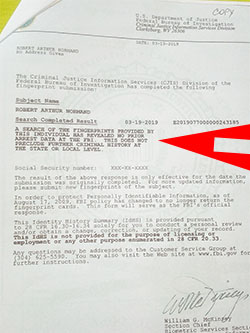 |
| First Page of the FBI Report - I'm Clean! |
Much of what an applicant does to get citizenship is similar to the process one goes through to get official residency status but you must do everything anew because you're dealing with TSE and not Inmigración. You can easily obtain a copy of the list of requirements at any TSE office. The TSE office in Quepos is located in the small strip mall near the Pali supermarket that also houses Farmacia Economica and Pizza Hut.
Of special concern in this process is the fact that one needs to obtain two critical documents: 1) an official copy of your birth certificate from the city or county registrar where you were born and which has been certified by the secretary of state in your state of birth and 2) a clean FBI report. As an aside, I'm told that both Inmigración and TSE have recently moved to FBI reports only, negating the possibility of submitting a state police report like I did for my original residency cédula.
For these two important docs I elected to use a document service in San José who promised (and delivered) the two U.S. based documents, both appropriately certified, within a month. Cost - $300 per document and, in my opinion well worth the service. You can review the process in the details link in the second paragraph below. With these two documents in hand you can proceed with obtaining the other documents and requirements, all of which can be done within Costa Rica.
Like the residency cédula, the two critical documents must not be "stale", defined as more than 90 days older than the date you submit them with your application.
There are eight other requirements (ten in all with the two key docs) that GG detailed in a previous edition in 2019. To see those details, go HERE. Getting this information together can be a rather tedious process but it's not difficult or overwhelming and, unlike the two key documents, they can all be obtained while you're living in Costa Rica.
After I had assembled all the required documents, they were submitted to TSE on September 20, 2019 for which I received a receipt. I thought I was done but, as these things go, there would be further "clarifications" required and other uncontrollable setbacks (particularly the COVID-19 crisis) that brought me back to the TSE office several times. Here's how it went:
- A few weeks after the final submission I received notice that my documentation for proof of income was inadequate. I had submitted a copy of my Social Security letter from the office at the Costa Rica U.S. Embassy, the same letter but newly updated, that had been used to get my original residency cédula. This proof of income had been good for Inmigración in 2012 but not for TSE now. Solving that question required a trip to a public accountant of TSE's approval and, after a few days, him verifying that my bank account here regularly receives the monthly SS check. After paying him 50,000 colones for his services, a letter from him was submitted to TSE to replace the SS letter. A few weeks after that I received an email from TSE stating my application had been approved. Yes!! A trip to TSE resulted in my learning that I would receive another email in about 20 days telling me what to do next (I had presumed at the time that the next email was about picking up the cédula - wrong!).
- No so fast amigo. A couple of weeks later I received another email saying there had been an objection filed. Evidently, another department at TSE, related to their court function, gets to review the findings and rule on them after the initial approval. This triggered another trip to the local TSE office where a clerk told us it's probably only a formality related to my requesting exemption from the Spanish language test requirement (if you're 65 or over, that exemption is available to you). We would learn later that the local clerk was right - not to worry.
- After a few more weeks of waiting, my friend/advisor and I tried to check progress at the local office but were turned away. By that time the country had begun the Coronavirus lock-down which also reduced the staff at the Quepos TSE branch. As a result of their staff cuts and general confusion on how to properly run a "socially-distanced" office they stated they were only doing delivery of cédulas and were not able to discuss those applications that were "en tramité" (in process), like myself, at that time. No action or status that day.
The Coronavirus turn away at TSE mentioned above, which happened around the third week of March, left another problem in its wake. My residency cédula was due to run out on April 25 and without a valid cédula it can become difficult to do certain banking and government transactions as well as running the risk of being an illegal resident. Not wanting to become a permanent tourist again and not knowing how long the process at TSE was really going to take I decided it would be prudent to renew the regular cédula just in case.
Once into the system as an official resident, renewals can be done at certain national banks like Banco de Costa Rica, which is my bank. I called a magic telephone number given me by the bank (BCR) and set up an appointment to renew it at the local branch; they gave me an appointment within a week (March 28). I was pleasantly surprised at how easy these renewals have become. In a few minutes they had snapped a new picture, asked me to sign off on proof of income (since BCR was my bank, they had proof of direct SS deposits that could be used to support my proof of income - no the bank can't do that for a citizenship) and they took my renewal fee money (about $100). They promised a new cédula by April 30. I actually received it in my P.O. Box on May 7. At least I'd be legal during the unknown waiting period for the citizenship process.
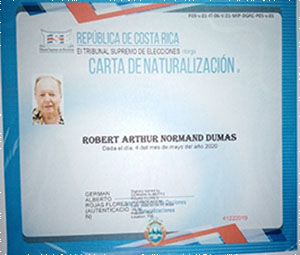 Back to the citizen cédula. On April 25 I received yet another TSE email indicating final approval, a naturalized citizenship certificate and my new 9-digit citizen cédula number (nyeh, nyeh I'm not going to tell you that number here) to replace my old 12-digit residency cédula. Instructions were that I wait 10 days (??) before contacting TSE to pick up the card and I did so. On May 8 I went to TSE again only to learn that, due to the office lock-down caused by the virus, they were NOT doing in-process applications like mine, the same status they were in a month earlier. The photo for the card and its issuance would have to wait.
Back to the citizen cédula. On April 25 I received yet another TSE email indicating final approval, a naturalized citizenship certificate and my new 9-digit citizen cédula number (nyeh, nyeh I'm not going to tell you that number here) to replace my old 12-digit residency cédula. Instructions were that I wait 10 days (??) before contacting TSE to pick up the card and I did so. On May 8 I went to TSE again only to learn that, due to the office lock-down caused by the virus, they were NOT doing in-process applications like mine, the same status they were in a month earlier. The photo for the card and its issuance would have to wait.
On the same day of that last visit Costa Rica announced they would continue the border freeze until June 15. I set my next target to check with TSE for June 17.
On May 25, while I was having lunch with a Tico friend, and on a whim, I asked him if he would call the local TSE office (I had the number from previous visits) and see if he could make an appointment for me to get a photo for my new cédula. After several minutes of rapid-fire but low-key, friendly Spanish the clerk said come on in tomorrow morning at precisely 9 AM. I did so, the clerk puttered with the computer for about ten minutes, then ushered me into a back room where she took my photo.
Q.E.D. (that's old engineering school jargon for Quod Erat Demonstrandum - meaning "That which was to be demonstrated has been"; one would often see this at the end of elaborate mathematical theorems. But in my school we used it to mean Quite Easily Done - it's also the GGU motto in the logo at the top). When I arrived home from the photo visit I had another email from TSE with an attached certificate confirming my citizenship (left, above). My mom would have liked my new Tico name as it includes her maiden name at the end (Dumas) like any self-respecting Tico would have.
The clerk gave me an appointment for the following Tuesday (June 2) at 1 PM. I showed up at that time and got the card in a matter of two minutes. Q.E.D. One of the nice things I saw on the new cédula was the renewal date, June 27, 2030, a full ten years from now!
Expenses to Obtain the Citizen Cédula
Let's summarize the expenses to get my new citizen cédula as best as I remember them:
- Birth Certificate and FBI Report - $600 ($300 each doc).
- Trip to San José (one) to engage the legal document service and provide fingerprints - $80 including an overnight stay (could be done in a one day trip though).
- Proof of Income from Accountant - 50,000 colones.
- Filing Fee for TSE Docs - 20,000 colones.
- Application publishing fee in La Gaceta - 20,000 colonies.
- Miscellaneous (photos, etc.) - 20,000 colones.
I make that out to be $680 + 110,000 colones ($193) = $873 and no worse than my initial residency application. Obviously the biggest potential for lessening these expenses is in obtaining the two critical reports - Birth Certificate and FBI Report. I elected to do this through a legal service in San José mentioned in the expense list above (read about it HERE). Not cheap but I believe the service they provided and relief of the hassle required on my part to do a deal from here with U. S. based government organizations, one in Washington, D.C. and one in Massachusetts, made it worth every dollar.
Post Cédula Clean-Up
When I got my new citizenship cédula the work was not quite done. TSE does not automatically notify other government agencies that a cédula number has changed; you have to do that yourself, to wit:
- Bank. On June 3 I spent an hour at the bank getting them to change the number on my account. As an old bank branch manager, but having dealt with this bank for about eight years, I have ceased to be amazed at the process complexity institutions here employ. What should have taken 10 minutes at most took one hour. (there I go again - damn complaining gringo)
- Health System. On June 4 I tried to get the number changed at C.C.S.S., at the Caja. I signed a form and went home. Had to stand outside in the sun because of the COVID distancing requirement. The next day I got an email from the Caja saying I needed to come in on Monday and sign another form. That I did on June 8 and I'm pretty sure the number was changed.
- Driver's License. This one was the most complex of all. When I went to get an update on a driver's license I learned that I needed to get the cédula number changed at COSEVI (Conseje de Seguridad Vial or Road Safety Council) who are responsible for licenses and car inspections. They are a division of MOPT (Ministerio de Obras Publico and Transportes, or. Ministry of Public Works and Transportation), essentially the Department of Transportation.
After a great deal of searching around the internet and learning that there were no opportunities for an interview in Perez-Zeledon (the closest Cosevi office to Quepos) in the following two weeks, I was able to set up an appointment at the Puntarenas Cosevi office for Friday, July 3. I'll let you know next month how this worked out.
- Passport. I had planned all along to get one of these and this turned out to be the simplest process of all. One phone call to the magic BCR Bank number mentioned above secured an appointment for the very next morning. I arrived about 10 minutes before my appointment and was ushered in to see the bank rep right on the appointment hour. After presenting him my new cédula he generated a couple of forms to sign, I paid a fee of some 43,000 colones (about $75), he took me picture and we were done. Q.E.D.
People have asked me why I bothered to go for citizenship. Holding a Costa Rican passport may offer some minor advantages in lower visa fees in traveling to other Latin American countries but that was not really important to me. My reason for doing this was simple; it makes me feel more a part of the country in which I live and which I love. Am I putting my U.S. citizenship in jeopardy? Hell no, I wouldn't have done it if that were the case but both the U.S and Costa Rica fully approve of dual citizenship without any hindrances. I will always be a Citizen of the United States of America, which I believe is the best form of government ever invented, but now I have a broader definition of being an "American", one that encompasses two American countries that I love.
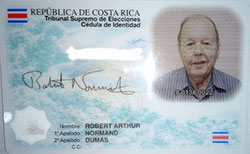 |
| GG's Cedula (Without Number) |
When I told a good Tico friend of mine that I was now a Tico he shot back that I must start acting like one and here are the requirements:
- You must eat rice and beans every day.
- You must always be happy (other world citizens expect it).
- You must always be 15 minutes late for any appointment.
- You can only choose between Saprissa and La Liga (the top two futbol teams).
- You must know how to jump start a car.
I will try my best to live up to these standards and so far I have maintained adherence to these principles (including participating in one jump start). And yes, it's always been Saprissa for me.
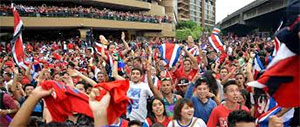 ¡Me he convertido en costarricense! (I have become a Tico!) ¡Que Padre! (Wow!)
¡Me he convertido en costarricense! (I have become a Tico!) ¡Que Padre! (Wow!)
For additional GGU topics covered in past editions on a variety of topics go here: GGU Archive.
¡Pura Vida!
TOP
Health Stuff
| Note: The information given in this section is offered as news information only and does not indicate GGC confirmation or denial of the accuracy of the treatment or a recommendation to pursue it, nor can we or do we guarantee the efficacy of the results nor validity of the conclusions proffered.
(How's that for a disclaimer amigos?) |
COVID-19 Case Load Spikes in Costa Rica
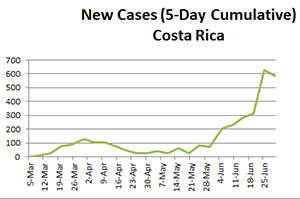 Some around the globe warned of secondary spikes and increases in Coronavirus case load. Unfortunately Costa Rica is currently experiencing such a fall back. It's all apparent from the chart to the right.
Some around the globe warned of secondary spikes and increases in Coronavirus case load. Unfortunately Costa Rica is currently experiencing such a fall back. It's all apparent from the chart to the right.
It sure seemed we had the virus beat at the end of April when a low new case load was experienced. Then, towards the end of May the new case load started to accelerate sharply reaching a peak of 347 new cases over a five day period (the chart depicts cumulative new cases over subsequent five-day periods). This caused authorities to reverse their decision about opening malls and the country has reverted to Phase 2 rules. The airports are not expected to reopen to tourists now until August 1.
Despite what is a recent, substantial rise in total case loads in Costa Rica, the death rate and recovery numbers are still more favorable (low and high, respectively) for Costa Rica than most other countries as seen in the chart below even when adjusted for population differences.

In addition, despite the surge in new cases, hospitalizations (now 40 and twice what they were a month ago) and death rates continue to be low (0.5% of cases and 3.2 per million population when compared to other countries.
Costa Rica Suspends Use Then Reinstates Hydroxychloroquine
The GGC, like others, has been asking the question as to how the fight against the Coronavirus in Costa Rica has produced better numbers (above) compared to other countries. Despite a recent spike in case load led by substantial increases in four of the cantons bordering Nicaragua in the north the COVID-19 recovery rate here continues to be high and the death rate lower than most countries around the world.
 Then, last month's Chronicle had a last minute update (May 30) stating that the use of Hydroxychloroquine in Costa Rica had been suspended effective that day because of an unidentified international report claiming the chemical could be dangerous. Turns out it was a report of an analysis published in the Lancet, a highly respected Dutch based publisher that specializes in medical publications.
Then, last month's Chronicle had a last minute update (May 30) stating that the use of Hydroxychloroquine in Costa Rica had been suspended effective that day because of an unidentified international report claiming the chemical could be dangerous. Turns out it was a report of an analysis published in the Lancet, a highly respected Dutch based publisher that specializes in medical publications.
Then on June 4 an announcement from Lancet stated that the study was being retracted by the researchers because: "the researchers were unable to complete an independent audit of the data underpinning their analysis" and that the side effects were not nearly as serious as had been presented. The CCSS (Costa Rica Health Department) immediately stated they would seek reinstatement of HCQ as a treatment within a few days.
One of the differences in treatment here is the early use of Hydroxychloroquine as soon as a patient tests positive. Evidently early treatment prevents the virus from developing to its more serious stages (sounds to me like that's a good explanation for the low death rate here). HCQ is produced in Costa Rica but just to be safe the Health Ministry accepted a gift from the Swiss pharmaceutical manufacture Novartis of 108,000 tablets to kick off the program.
Costa Rica Begins Trial on Dexamethasone
On the other end of the treatment protocol, recent trials in Great Britain have indicated up to a one-third reduction in fatalities in COVID infected patients by the use of dexamethasone during the more advanced stages of the disease.
 Costa Rica has begun a trial on 19 of our more severely infected patients using dexamethasone. Said the British trail team: “Dexamethasone is the first medicine that we observed that improves survival in the case of COVID-19.” The team said that dexamethasone is contra-indicated for treatment of early infections but has an anti-inflammatory effect that is appropriate for the later, more severe stages of the disease when patients require oxygen or ventilators (be sure to read the next article on ventilators).
Costa Rica has begun a trial on 19 of our more severely infected patients using dexamethasone. Said the British trail team: “Dexamethasone is the first medicine that we observed that improves survival in the case of COVID-19.” The team said that dexamethasone is contra-indicated for treatment of early infections but has an anti-inflammatory effect that is appropriate for the later, more severe stages of the disease when patients require oxygen or ventilators (be sure to read the next article on ventilators).
Perhaps the combination of HCQ in the early stages combined with DMS for the more progressed stages will offer a superior treatment until a vaccine is developed. Let's hope so.
Costa Rica Invents Its Own Ventilator
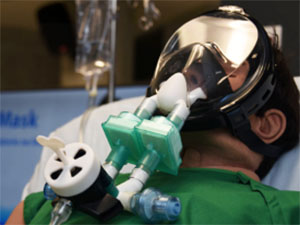 In an entrepreneurial spirit, and to help fight the Coronavirus, the University of Costa Rica School of Medicine has come up with a new design for a ventilator.
In an entrepreneurial spirit, and to help fight the Coronavirus, the University of Costa Rica School of Medicine has come up with a new design for a ventilator.
This new unit (left) is unique in that it does not require intubation, that is, the use of a plastic tube inserted down someone's throat. The unit, called a "Fluxus Mask" serves as a combination of breathing machine and isolation mask. It also does not require electricity, being patterned after scuba gear and operated on compressed air, eliminating the need for electricity, a feature that can be very important in many places around the world that do not have a reliable source of electricity
The device was prototyped focusing on using materials (washable and reusable filters, valves and tubes) readily available in Costa Rica. The Fluxus Mask has passed preliminary clinical tests and is awaiting final approval by the Ministry of Health. And just to sweeten the invention a little more, the cost of a Fluxus Mask is projected to be $2,000, one fifth the cost of a typical invasive ventilator.
The men and women of UCR have done it again, ¡Felicidades, Amigos!
¡Pura Vida!
TOP
Travel Quote of the Month
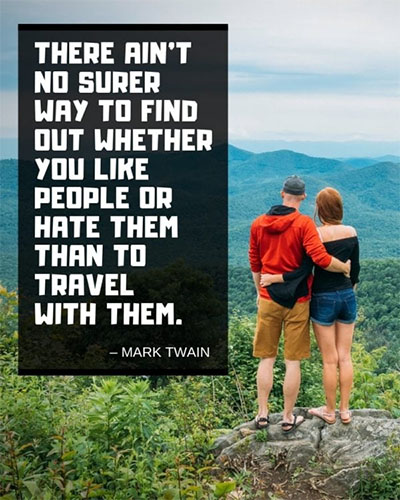
Ain't that the truth...
¡A Cachete!
TOP
GGC Bookshelf
The latest book to hit the market is a new book by Robert A. Normand (aka GG, and yes, this is a plug) entitled Las Esferas, Mystery Spheres of Costa Rica. Check out the cover on the list below and click on the "Read More" button to review a synopsis of the work and to order.

GGC Publications is the parent organization that publishes the Golden Gringo Chronicles as well as a number of books and paraphernalia related to the Chronicles and Costa Rica. The GGC Bookshelf also includes works from a number of other authors that belong to various writers groups based in Costa Rica including the Quepos-Manuel Antonio Writers Group.
Here are the books currently on our bookshelf:
All of the above books are available on Amazon.com and the "Read More" links above will lead you to them. You can find more detail on all of them on our GGC Publications Page.
GGC Products Store
GGC Publications also offers some accessories and paraphernalia related to the Chronicles and with Costa Rican themes, to wit:
T-Shirts:

a. Golden Gringo Chronicles with Logo,
b. Official Golden Gringo with Monkey on Banana Hammock,
c. ¡Quepo en Quepos! ("I Fit In Quepos!") with Photo of Quepos,
d. Wanna Monkey Around? - Come on Down! (shown) with Photo of White Faced Monkey,
e. It's OK to be Slothful with photo of Three-Toed Sloth.
The t-shirts are available in several themes, colors, styles and sizes. See them all HERE.
Coffee Mugs:
a. Golden Gringo, b. Wanna Monkey Around?, c. It's OK to be Slothful
See them all HERE:
What's life without a great cup of Costa Rican coffee? And it tastes even better in a Golden Gringo Chronicles mug!
To see ALL the products available in the Golden Gringo Store go here: GGC Store.
¡Solo Bueno!
What's-in-a-Word
"Tell me and I forget; teach me and I remember; involve me and I learn"
– Benjamin Franklin
Answer to Que Es Eso?
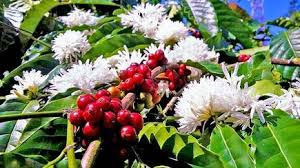
The flowering plant is a coffee plant that bursts out in white flowers in the early dry season then produces "cherries" in which the bean is housed.
Only the ripe, red cherries are picked, from which the bean is extracted, roasted and ground.
Etymology of Coffee
 Using Google as the ultimate source:
Using Google as the ultimate source:
The word "coffee" entered the English language in 1582 via the Dutch koffie, borrowed from the Ottoman Turkish kahve, in turn borrowed from the Arabic qahwah (قهوة).
¡Pura Vida!
TOP
ROMEO Corner
(Retired Old Men Eating Out)
Restaurant: Chicken on the Run, Quepos
Location: Main drag into town across from Coopeallianza Credit Union and Pali.
Hours: Lunch, Dinner Monday thru Sunday 11:00 AM to 11 PM
Parking: Ample lot behind restaurant.
Contacts: Tel:
2774 0246; Facebook: Chicken on the Run
Reviewing ROMEOS: Bob N. Jessie P., Lee W.
To Review Our Rating System Go Here: R.O.M.E.O. Rating System
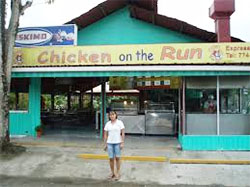 This place might be thought of as a working man's restaurant; rapid service, good food, convenient to downtown. The atmosphere, a roof but otherwise open, is very plain and functional. This place has been a favorite among the locals for as long as I've lived in Quepos so that's at least more than 12 years. We gave the restaurant a 3.0/5.0 sloth rating for ambiance.
This place might be thought of as a working man's restaurant; rapid service, good food, convenient to downtown. The atmosphere, a roof but otherwise open, is very plain and functional. This place has been a favorite among the locals for as long as I've lived in Quepos so that's at least more than 12 years. We gave the restaurant a 3.0/5.0 sloth rating for ambiance.
The cafeteria service includes an assortment of fried and roast chicken, ribs (costillas) and salad ranging from chimichurry to ensalada russa (Russian or beet salad). You can also get a pretty good cheeseburger here (the real Tico kind with a slice of ham on the top layer (otherwise it wouldn't be a "ham"burger).
GG got his favorite: costillas, barbecued ribs, always flavorful, with puree de papa (mashed potatoes - they were out of yucca at the moment; "no hay yucca") and ensalada russa (beet salad). With a tall glass of ice and piña con arroz (rice and pineapple liquefied together with water in a blender) it was a tasty lunch.
The other two ROMEOs went for the fried chicken with chimichurry and one of the salads. One ROMEO described this restaurant as "the best place for fried chicken in Quepos.
The composite score for food quality came in at 3.8/5.0.
|
 |
 .8 .8 |
| $$$.3 |
Value Index= 115 |
The cafeteria style minimized direct service but all the personnel we were in contact with were polite and had a smile. When we hung around a while after finishing our meal, one server came, cleared off our table and cleaned it. The composite score for service was 4.3/5.0 sloths. That resulted in an overall rating of 3.8/5.0 for ambiance, food quality and service.
For all three lunches the cost came in at 9,400 colones or about $16 (about as close to a good $5 lunch as you can get). The composite rating for cost came in at 3.3/5.0 which yielded a value index of 3.8/3.3 = 115 placing Chicken on the Run right in the middle of values for the restaurants in this area.
Chicken on the Run continues to be a good bet for a quick, good and filling lunch at a reasonable cost for this area.
¡Solo Bueno!
TOP
Opt-In Here to Receive Your Free Monthly Copy Of
The Golden Gringo Chronicles
The Golden Gringo Chronicles is a free newsletter that is non-political, non-commercial and, hopefully, informative and entertaining. By signing up you will receive an email each month around the first of the month giving you the links to the latest edition as well as to each individual feature and departmental section.
CLICK HERE TO SIGN-UP FOR THE GOLDEN GRINGO CHRONICLES
or Email me at gg@goldengringo.com, or use our Website at: www.goldengringo.com

Bob Normand, Editor & The Golden Gringo
Pura Vida!
To Contact GGC World Headquarters (yuk, yuk) to makecomments, suggest topics or criticize my bad jokes, just send an email to: gg@goldengringo.com.
Be pithy but kind; I'm sensitive.
Unsubscribe from the Golden Gringo Chronicles
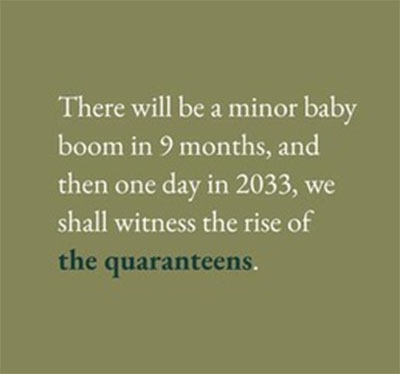




 Hard on the heels of the Chinese pledge to help out in the Coronavirus, the United Arab Emirates recently sent a plane with nine tons of COVID fighting supplies as well as 10,000 testing kits. The plane also included a number of Costa Rican officials returning to their homeland. With an added personal touch, the UAE ambassador to Costa Rica was on the plane and personally delivered the supplies to Juan Santamaria Airport on Friday, May 12.
Hard on the heels of the Chinese pledge to help out in the Coronavirus, the United Arab Emirates recently sent a plane with nine tons of COVID fighting supplies as well as 10,000 testing kits. The plane also included a number of Costa Rican officials returning to their homeland. With an added personal touch, the UAE ambassador to Costa Rica was on the plane and personally delivered the supplies to Juan Santamaria Airport on Friday, May 12. The Italian restaurant chain Olive Garden, with some 850 restaurants in the U.S. and about the world, has been planning for some time to enter Costa Rica. They had originally targeted July for opening of two restaurants in the Central Valley in Santa Ana and Escazu but the situation with COVID has changed their opening plan to September.
The Italian restaurant chain Olive Garden, with some 850 restaurants in the U.S. and about the world, has been planning for some time to enter Costa Rica. They had originally targeted July for opening of two restaurants in the Central Valley in Santa Ana and Escazu but the situation with COVID has changed their opening plan to September. The Costa Rica legislature some time ago passed a revision to the tax code that in essence replaces the current tax system with a VAT (Value Added Tax) system. At the same time, spurred on by mounting deficits, deteriorating international credit and poor fiscal performance ratings, the new tax code broadens the number of products and services which are to come under the VAT system.
The Costa Rica legislature some time ago passed a revision to the tax code that in essence replaces the current tax system with a VAT (Value Added Tax) system. At the same time, spurred on by mounting deficits, deteriorating international credit and poor fiscal performance ratings, the new tax code broadens the number of products and services which are to come under the VAT system. The major shopping malls in Costa Rica, primarily in the Central Valley (e.g., Multi-Plaza in Escazu and City Mall in Alejuela) were reopened for business on the weekend of June 20, Father's Day, after being closed for over three months because of the pandemic.
The major shopping malls in Costa Rica, primarily in the Central Valley (e.g., Multi-Plaza in Escazu and City Mall in Alejuela) were reopened for business on the weekend of June 20, Father's Day, after being closed for over three months because of the pandemic.  What's unusual about this 6,600 square meter (70,000 square foot) store is that it's the first time PriceSmart has ventured outside the San José GAM (Grande Area Metropolitano or Greater Metropolitan Area). The store is in Liberia, a town in North Western Costa Rica which is more and more seen as an important commercial hub.
What's unusual about this 6,600 square meter (70,000 square foot) store is that it's the first time PriceSmart has ventured outside the San José GAM (Grande Area Metropolitano or Greater Metropolitan Area). The store is in Liberia, a town in North Western Costa Rica which is more and more seen as an important commercial hub.  SYKES ENTERPRISES, INCORPORATED is a leading provider of multi-channel demand generation and global customer engagement services. The Company provides differentiated full life-cycle customer engagement solutions and services primarily to Global 2000 companies and their end customers.
SYKES ENTERPRISES, INCORPORATED is a leading provider of multi-channel demand generation and global customer engagement services. The Company provides differentiated full life-cycle customer engagement solutions and services primarily to Global 2000 companies and their end customers.
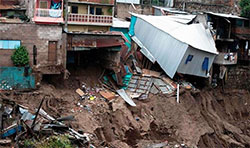
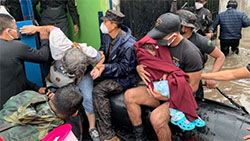








 The YouTube history report on which much of this article is based talks about a sheppard who noticed that his flock was unusually active after eating the berries of a certain bush. That bush turned out to be an arabica plant. The sheppard tried eating the ripe, red berries straight from the bush like his flock did; he found them bitter and they did not increase his energy. Later he discovered that some berries had accidentally fallen into a cooking pan where they were unintentionally roasted and when crushed and dissolved in water, the odoriferous and tasty liquid that resulted changed everything. Le voila! For many years thereafter, and even today, it is not unusual to see coffee beans skillet-roasted over an open fire in parts of the world, particularly Arabia where it often is done ceremoniously.
The YouTube history report on which much of this article is based talks about a sheppard who noticed that his flock was unusually active after eating the berries of a certain bush. That bush turned out to be an arabica plant. The sheppard tried eating the ripe, red berries straight from the bush like his flock did; he found them bitter and they did not increase his energy. Later he discovered that some berries had accidentally fallen into a cooking pan where they were unintentionally roasted and when crushed and dissolved in water, the odoriferous and tasty liquid that resulted changed everything. Le voila! For many years thereafter, and even today, it is not unusual to see coffee beans skillet-roasted over an open fire in parts of the world, particularly Arabia where it often is done ceremoniously. A few hundred years later Turkish caravans passing through Ethiopia discovered coffee and how to prepare it. They brought plants back to Istanbul where many of the rich and powerful fell in love with the brew. Turkish authorities were very careful to keep the secret of the beans to themselves and from the world for a long time but eventually someone cleverly smuggled beans out of Turkey. He secreted some of the beans under his clothes tied to his stomach. Word of the magic elixir spread to other lands.
A few hundred years later Turkish caravans passing through Ethiopia discovered coffee and how to prepare it. They brought plants back to Istanbul where many of the rich and powerful fell in love with the brew. Turkish authorities were very careful to keep the secret of the beans to themselves and from the world for a long time but eventually someone cleverly smuggled beans out of Turkey. He secreted some of the beans under his clothes tied to his stomach. Word of the magic elixir spread to other lands.
 The French adopted the coffee house tradition with relish but eventually took to calling them cafés. One of the more famous of their cafés, which is still in operation today, is the Café de Flore - shown in the photo to the left.
The French adopted the coffee house tradition with relish but eventually took to calling them cafés. One of the more famous of their cafés, which is still in operation today, is the Café de Flore - shown in the photo to the left.  The first coffee reached England in the mid-1600's followed soon by the opening of the first coffee house in London by a Armenian Jewish immigrant named Pasqua Rosée who had connections with bean suppliers in the Mediterranean. The space where Rosée's coffee house first existed, in St. Michael's Alley, Cornhill is currently occupied by the Jamaica Wine House (don't know what kind of coffee they offer in addition to wine). By 1700 there were over 200 coffee houses in England that were dubbed with the nickname "Penny Universities" because of all the information that was passed in them.
The first coffee reached England in the mid-1600's followed soon by the opening of the first coffee house in London by a Armenian Jewish immigrant named Pasqua Rosée who had connections with bean suppliers in the Mediterranean. The space where Rosée's coffee house first existed, in St. Michael's Alley, Cornhill is currently occupied by the Jamaica Wine House (don't know what kind of coffee they offer in addition to wine). By 1700 there were over 200 coffee houses in England that were dubbed with the nickname "Penny Universities" because of all the information that was passed in them. 

 The first thing to realize in this process is that, unlike getting an official residency cédula (a cédula is an official identification card similar to a credit card), you are not dealing with the immigration department (called Inmigración here). Instead you will be working with the TSE (Tríbunal Supremo de Elecciones - Supreme Court of Elections). This is an organization that was instituted at the same time that the constitution of the Second Republic was adopted in 1949. It was formed with the intention of securing valid and democratic elections, a deep concern in the country at that time as they struggled to emerge from a bitter civil war.
The first thing to realize in this process is that, unlike getting an official residency cédula (a cédula is an official identification card similar to a credit card), you are not dealing with the immigration department (called Inmigración here). Instead you will be working with the TSE (Tríbunal Supremo de Elecciones - Supreme Court of Elections). This is an organization that was instituted at the same time that the constitution of the Second Republic was adopted in 1949. It was formed with the intention of securing valid and democratic elections, a deep concern in the country at that time as they struggled to emerge from a bitter civil war. 

 Back to the citizen cédula. On April 25 I received yet another TSE email indicating final approval, a naturalized citizenship certificate and my new 9-digit citizen cédula number (nyeh, nyeh I'm not going to tell you that number here) to replace my old 12-digit residency cédula. Instructions were that I wait 10 days (??) before contacting TSE to pick up the card and I did so. On May 8 I went to TSE again only to learn that, due to the office lock-down caused by the virus, they were NOT doing in-process applications like mine, the same status they were in a month earlier. The photo for the card and its issuance would have to wait.
Back to the citizen cédula. On April 25 I received yet another TSE email indicating final approval, a naturalized citizenship certificate and my new 9-digit citizen cédula number (nyeh, nyeh I'm not going to tell you that number here) to replace my old 12-digit residency cédula. Instructions were that I wait 10 days (??) before contacting TSE to pick up the card and I did so. On May 8 I went to TSE again only to learn that, due to the office lock-down caused by the virus, they were NOT doing in-process applications like mine, the same status they were in a month earlier. The photo for the card and its issuance would have to wait.
 ¡Me he convertido en costarricense! (I have become a Tico!) ¡Que Padre! (Wow!)
¡Me he convertido en costarricense! (I have become a Tico!) ¡Que Padre! (Wow!) Some around the globe warned of secondary spikes and increases in Coronavirus case load. Unfortunately Costa Rica is currently experiencing such a fall back. It's all apparent from the chart to the right.
Some around the globe warned of secondary spikes and increases in Coronavirus case load. Unfortunately Costa Rica is currently experiencing such a fall back. It's all apparent from the chart to the right.
 Then, last month's Chronicle had a
Then, last month's Chronicle had a  Costa Rica has begun a trial on 19 of our more severely infected patients using dexamethasone. Said the British trail team: “Dexamethasone is the first medicine that we observed that improves survival in the case of COVID-19.” The team said that dexamethasone is contra-indicated for treatment of early infections but has an anti-inflammatory effect that is appropriate for the later, more severe stages of the disease when patients require oxygen or ventilators (be sure to read the next article on ventilators).
Costa Rica has begun a trial on 19 of our more severely infected patients using dexamethasone. Said the British trail team: “Dexamethasone is the first medicine that we observed that improves survival in the case of COVID-19.” The team said that dexamethasone is contra-indicated for treatment of early infections but has an anti-inflammatory effect that is appropriate for the later, more severe stages of the disease when patients require oxygen or ventilators (be sure to read the next article on ventilators). In an entrepreneurial spirit, and to help fight the Coronavirus, the University of Costa Rica School of Medicine has come up with a new design for a ventilator.
In an entrepreneurial spirit, and to help fight the Coronavirus, the University of Costa Rica School of Medicine has come up with a new design for a ventilator. 













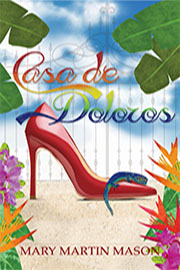





 Using Google as the ultimate source:
Using Google as the ultimate source: This place might be thought of as a working man's restaurant; rapid service, good food, convenient to downtown. The atmosphere, a roof but otherwise open, is very plain and functional. This place has been a favorite among the locals for as long as I've lived in Quepos so that's at least more than 12 years. We gave the restaurant a 3.0/5.0 sloth rating for ambiance.
This place might be thought of as a working man's restaurant; rapid service, good food, convenient to downtown. The atmosphere, a roof but otherwise open, is very plain and functional. This place has been a favorite among the locals for as long as I've lived in Quepos so that's at least more than 12 years. We gave the restaurant a 3.0/5.0 sloth rating for ambiance.
